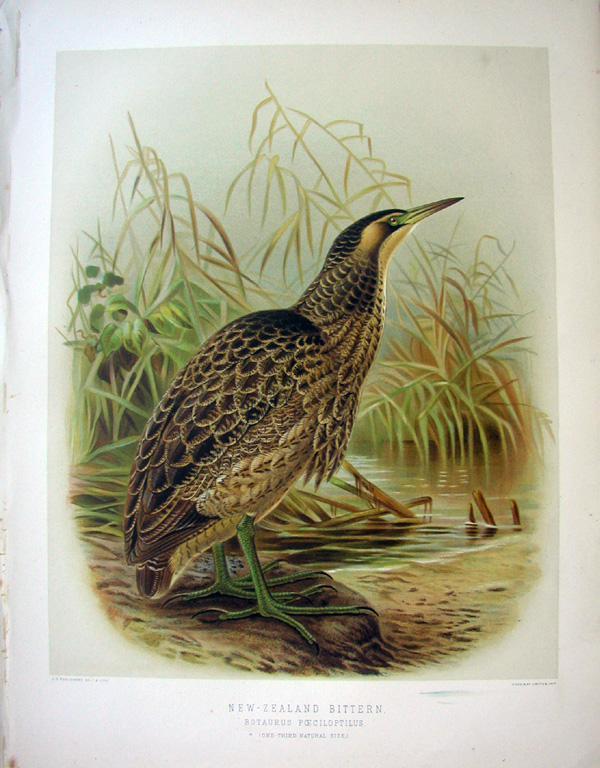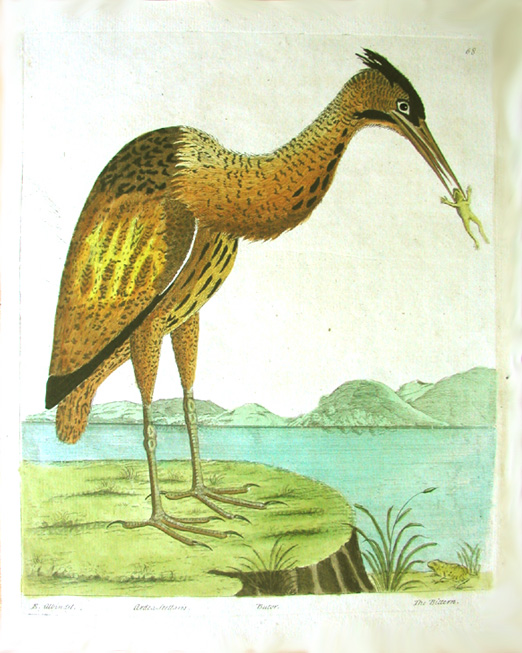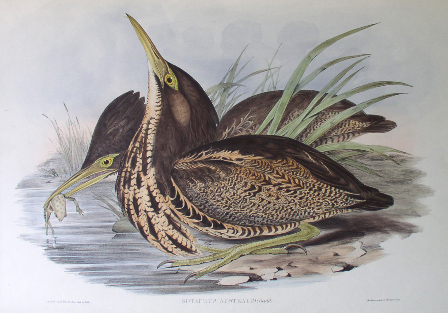


Buller, Walter Lawry, Birds of New Zealand, 1888.
One of those magical days, all green and blue and gold. The flax and the pohutakawa are coming into bloom and the Tui are out and about, wings whirring, noisily checking out the state of the nectar. Kotare, the kingfisher is piping away along with the constant chirping of the yellow hammer. A scattered heap of snail shells reveals where a thrush has used a lump of wood on the farm track for an anvil. Such an unlikely place but I do not pause to dwell on it as I am in pursuit of different game this morning.
Last week just as dusk approached, a couple of birds making their way across the paddocks towards a small wetland reserve down below the house caught my attention. I dashed for the binoculars as they just did not look like ducks. They were, as I suspected, Australasian bittern, behaving quite strangely.
They were both large birds but one appeared to be in charge, nervously jumping about and marshalling the other bird, which did not seem to want to fly, across the paddocks and over the drains. I wondered if it was a mother with a well grown fledgling but really could not make any sense of their behaviour. They are such shy secretive birds, active usually at night, so that there seems little information to be found about their behaviour. One Australian report I found says that courtship behaviour involves the male having its neck inflated and jumping in the air, which could well have been what I was observing.
The paddocks lie just besides a small swampy area, which has a pond and lot of cover, raupo and rushes. The swampy area is only perhaps a hectare but over the last three years has been turned into a small reserve, a remnant of the swamps that had been here around the edge of the Harbour. Fenced off and protected from farm runoff, it also has frogs, not many, but enough to attract bitterns.
So this morning I am quietly checking out the area, just to see if I can spot any activity. In the twenty or so years I have lived in the district, I have seen bitterns no more than perhaps six times so count it wonderful to perhaps have a bittern nesting here.
Some ornithologists consider the Australasian bittern to be a subspecies of Botaurus stellaris, the bittern of the old world, whilst others do not agree and consider the bird from this region to be a separate species, Botaurus poiciloptilus. Nonetheless, all four species of Botaurus, although found in separate areas, are much alike and are considered by some commentators to be one super species.
Of the New Zealand writers, Oliver gives the fullest and best account. He says that “the bittern was formerly found in all swamps and lagoons where there was vegetation consisting of reeds, such as rushes and raupo, Typha orientalis. In such situations, its habit of remaining motionless with its head erect renders it difficult to detect even at close quarters. Through the draining of swamps and advance of settlement the bittern is retreating but is still to be met throughout the country”.
“The bittern’s fare includes a varied assortment of animal foods: insects, crustacea, fishes, spiders, lizards, birds and the introduced frogs, rats and mice. The fish includes eels and other freshwater fish”.
However, since Oliver wrote this the bird has continued to retreat until now it probably numbers less than a thousand birds, to be found mostly in Northland, Waikato, Bay of Plenty, Manawatu and southern Wairarapa. Also the frog, the Australian introduced frog, has all but disappeared of late leaving many of us wondering how far this has affected the bittern, as it appeared to have become dependant upon them as a food source with the retreating of the swamps. Certainly bitterns used to be considered fairly common around here in farm drains that seldom now have frogs.
The male bittern’s booming season is said to be very long, proclaiming its territory to females and rival males from mid-winter to late summer. It is said to sound rather like the roaring of a bull in the distance. Polygamy has been confirmed in the European bird where a number of females have been recorded nesting on one area with only one male. Males are extremely aggressive, fighting both on the ground and in flight, endeavouring to stab or spear their opponents, perhaps even to death.
“The nest of the bittern is a flat structure made of rushes, raupo and such drift borne sticks as are handy, its top being raised only a few inches above the ground. It is always situated in swamp well hidden among dense rushes and often on outlying patches surrounded by water or soft mud. Four is the usual number of eggs.”
The male has not been observed to help either with making the nest or with the rearing of the young. “The habit of remaining motionless when danger threatens is developed in the young at an early age for chicks one to five days old immediately froze themselves into snags, each little head and bill pointing skywards at an odd angle. The egg laying period extends from the end of August to the middle of January.” The young birds are fully fledged in seven weeks and then disperse quite rapidly.
Bittern’s feathers are much fancied by trout fishermen as they apparently look a lot like whitebait when trailed in the water.
The American species has attracted much folklore. Thoreau called the bittern, “the genius of the bog”.
Narena Olliver — Godwit House, Ohiwa, 2002.


Albin's “Natural History of British Birds”, 1st edition.
| Taxonomy | |
|---|---|
| Kingdom: | Animalia |
| Phylum: | Chordata |
| Class: | Aves |
| Order: | Ciconiiformes |
| Family: | Ardeidae |
| Genera: | Botaurus |
| Species: | poiciloptilus |
| Sub Species: |
Botaurus australis.
Native bird
71 cm., males 1400 g., females 1000 g., mottled brown and buff, heavy in flight.

Widely distributed but rare.
Me he huuroto au kei roo repo,
Me he kaaka, e whakaraaoa ana!
I am like a bittern in the swamp,
A bittern with its choking cry!
— Orbell 1985
A Maori Lullaby
Hark! the bittern calls her children
from the willow-weed and marsh-logs,
And the lonely little swamp bird
Wades no more about the black bogs.
See the kelpies of the starshine,
Peeping each one through a blue bough,
Hearken to the voice of Rangi
Singing as I sing to thee now.
Sleep, my bright eyed little weka,
Sleep, mu huia-bird of twilight,
Sleep, my brown moth of the branches,
Ate! Ate! Ate! Ate!
Hush -oh hush! my little wild one,
Hear the stirring in the hollow,
With thy restless little crying
Thou wilt wake the small sea-swallow.
Dearer than the bread of raupo,
Dearer than the sweet konini,
Dearer thah the dead to Tane,
Yea, so dear art though unto me.
Sleep, my bud of koromiko,
Sleep, my wild karaka berry,
Sleep, my red-lipped rata-blossom;
Ate! Ate! Ate! Ate!
— Eileen Duggan
Buller, Walter Lawry, Birds of New Zealand, 1888.
Albin's “Natural History of British Birds”, 1st edition, was published in London between 1731–38.
John Gould’s Birds of Australia, (1840-1848).
Heather, B., & Robertson, H., Field Guide to the Birds of New Zealand, 2000.
Oliver, W.R.B. New Zealand Birds, 1955.
Tuesday, 15 August, 2023; ver2023v1